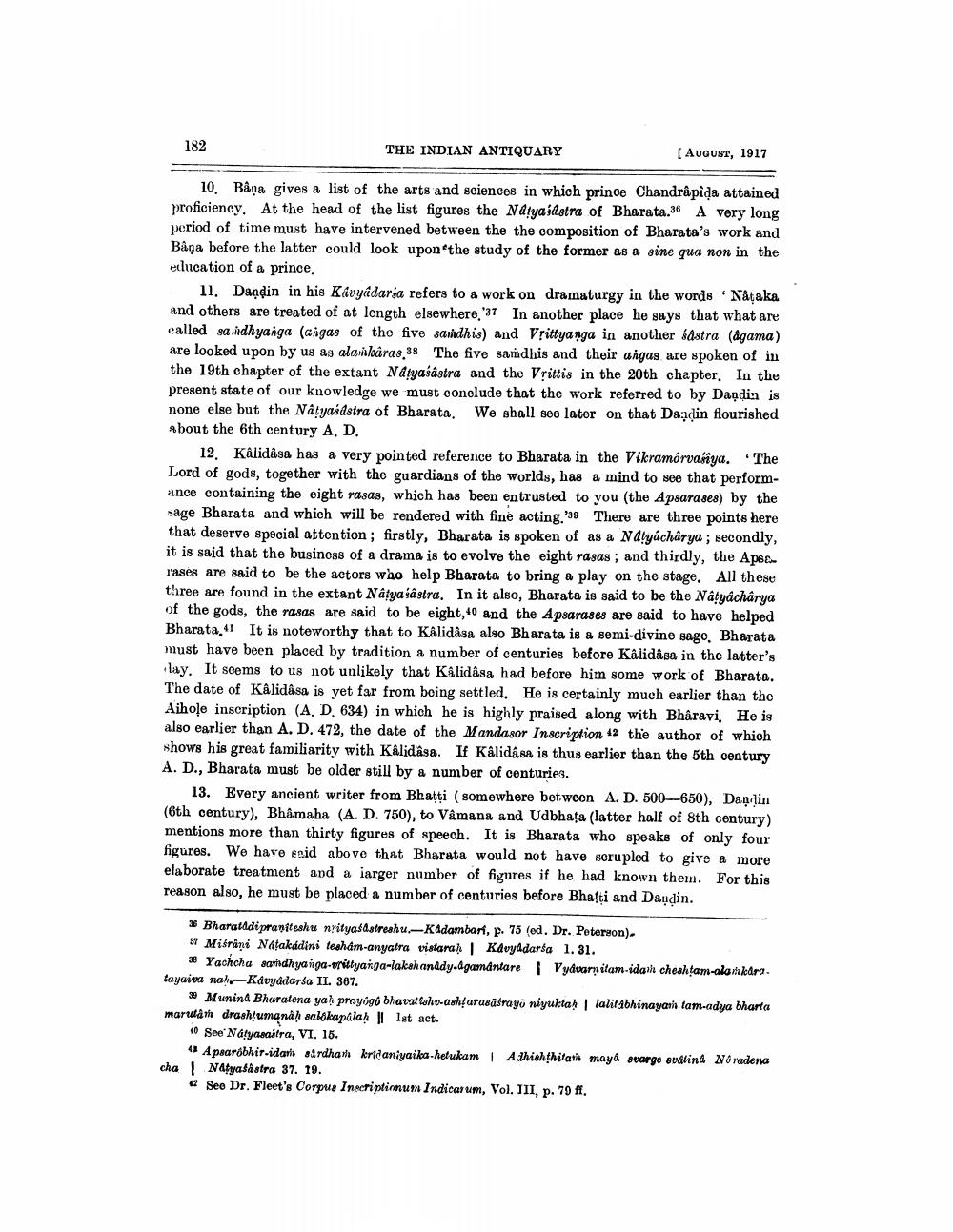________________
182
THE INDIAN ANTIQUARY
[AUGUST, 1917
10. Bâna gives a list of the arts and sciences in which prince Chandrápida attained proficiency. At the head of the list figures the Natyasastra of Bharata.36 A very long period of time must have intervened between the the composition of Bharata's work and Båņa before the latter could look upon the study of the former as a sine qua non in the education of a prince.
11. Daņdin in his Kavyadarsa refers to a work on dramaturgy in the words Nataka and others are treated of at length elsewhere, '37 In another place he says that what are called sa idhyanga (Gigas of the five sandhis) and Vrittyanga in another sästra (agama) are looked upon by us as alankaras,38 The five samdhis and their angas are spoken of in the 19th chapter of the extant Natyasastra and the Vrittis in the 20th chapter. In the present state of our knowledge we must conclude that the work referred to by Daņdin is none else but the Natyaśdstra of Bharata. We shall see later on that Dadin flourished about the 6th century A. D.
12. Kalidasa has a very pointed reference to Bharata in the Vikramõrvasiya. The Lord of gods, together with the guardians of the worlds, has a mind to see that performance containing the eight rasas, which has been entrusted to you (the Apsarases) by the sage Bharata and which will be rendered with fine acting.°39 There are three points here that deserve special attention; firstly, Bharata is spoken of as a Nalyacharya ; secondly, it is said that the business of a drama is to evolve the eight rasas; and thirdly, the Apec rases are said to be the actors who help Bharata to bring a play on the stage. All these three are found in the extant Natya sastra. In it also, Bharata is said to be the Natyacharya of the gods, the rasas are said to be eight, 40 and the Apsarases are said to have helped Bharata. 41 It is noteworthy that to Kalidasa also Bharata is a semi-divine sage. Bharata must have been placed by tradition a number of centuries before Kalidasa in the latter's
lay. It seems to us not unlikely that Kalidasa had before him some work of Bharata. The date of Kalidasa is yet far from being settled. He is certainly much earlier than the Aihole inscription (A, D, 634) in which he is highly praised along with Bhåravi. He is also earlier than A. D. 472, the date of the Mandasor Inscription 12 the author of which shows his great familiarity with Kálidasa. If Kalidasa is thus earlier than the 5th century A. D., Bharata must be older still by a number of centuries.
13. Every ancient writer from Bhatti ( somewhere between A. D. 500---650), Danin (6th century), Bhâmaha (A. D. 750), to Vâmana and Udbhata (latter half of 8th century) mentions more than thirty figures of speech. It is Bharata who speaks of only four figures. We have said above that Bharata would not have scrupled to give a more elaborate treatment and a larger number of figures if he had known them. For this reason also, he must be placed a number of centuries before Bhatti and Daudin.
35 Bharatdipraniteshu nyityafdstreahu,-Kadambari, p. 75 (od. Dr. Peterson). 37 Misrani Natakádini tesham-anyatra vistara) | Kdoyadarsa 1. 31.
38 Yachcha saridhyanga-vrittyanga-lakshanddy.Agamantare | Vyavarnitam-idan choshtam-alankara. tayaiva nal.-Kdvyadarsa II. 367.
39 Munina Bharatena yal prayogó bharat lahu-ashfarasüsrayo niyuktah lalit abhinayara tam-adya bharta martuar drashtumanah solókapala || Ist act.
0 See Nayasaitra, VI. 15.
41 Apsaróbhir-idari sirdhan kridaniyaika hetukam | Ashishthitati maya svarge sudlina Noradena cha | Natyasastra 37. 19.
? Seo Dr. Fleet's Corpus Inscriptimum Indicarum, Vol. III, p. 79 ff.




